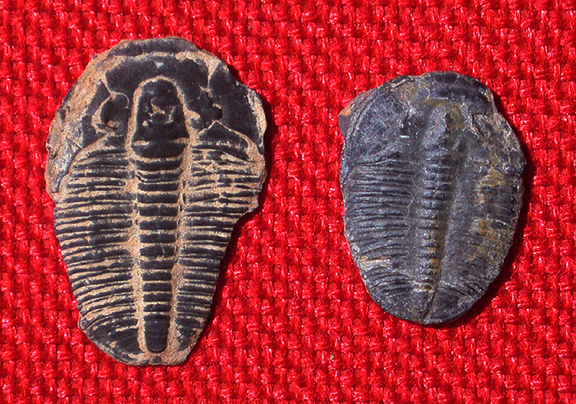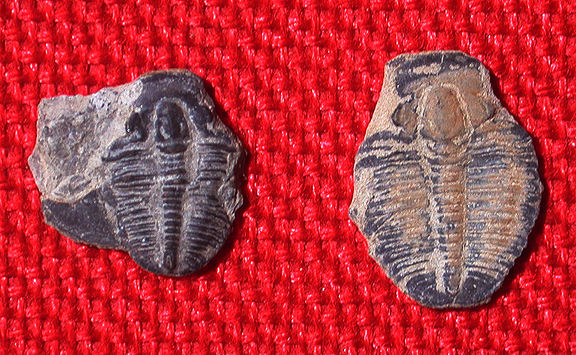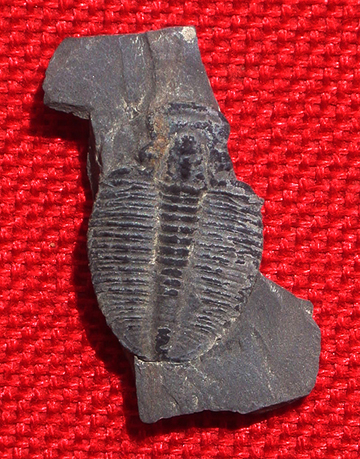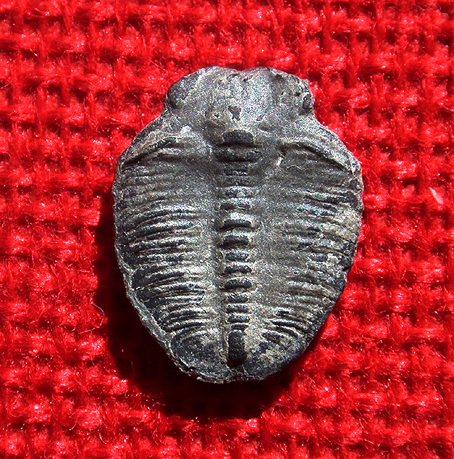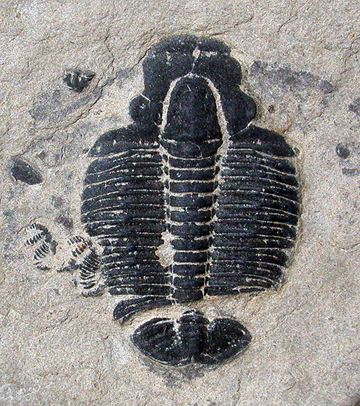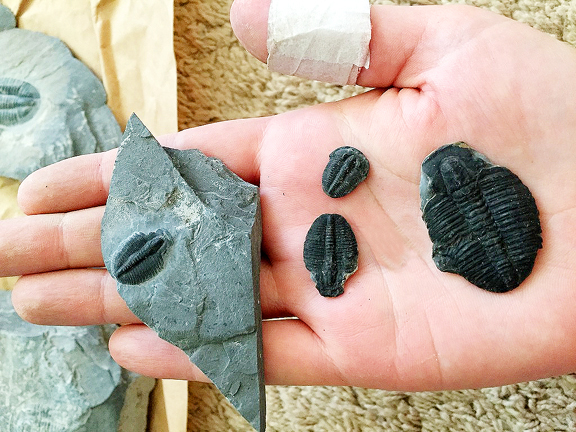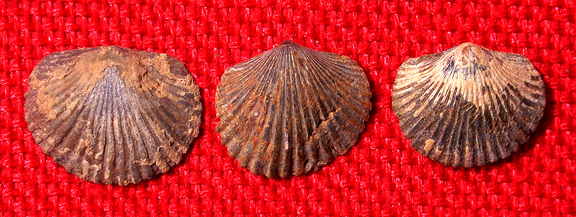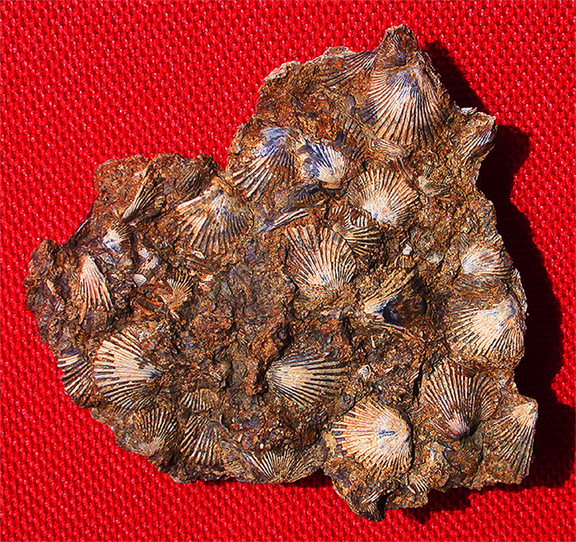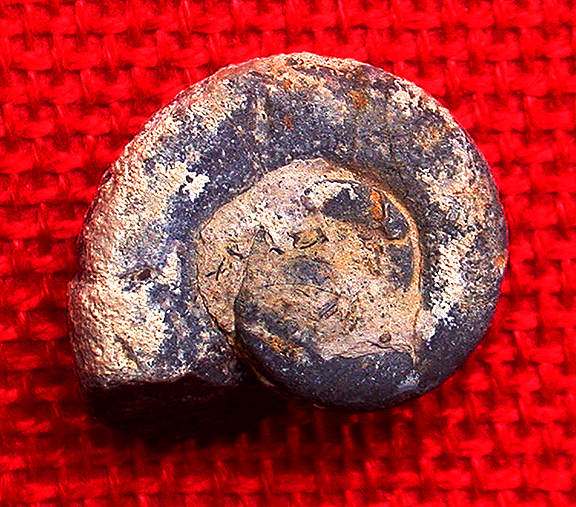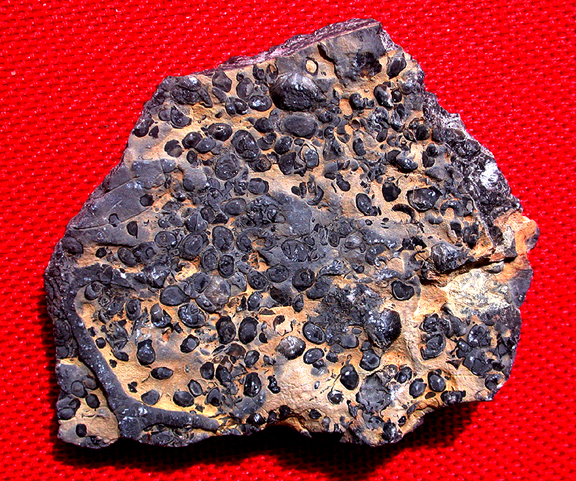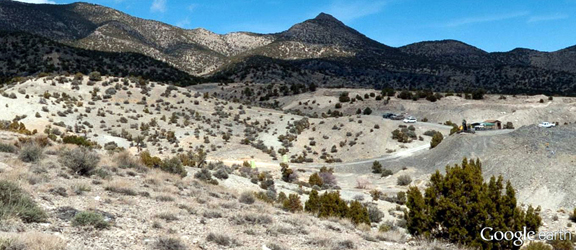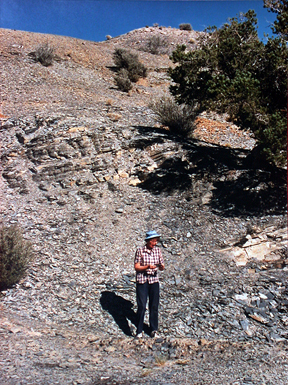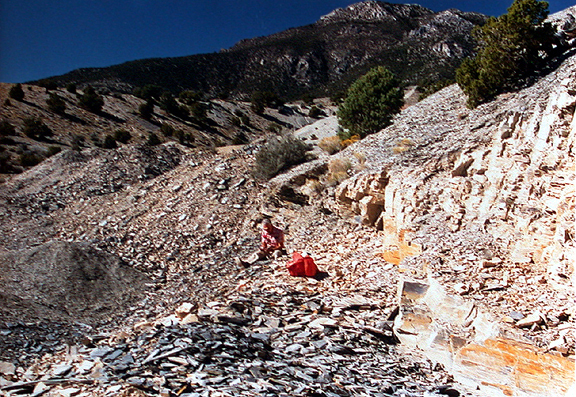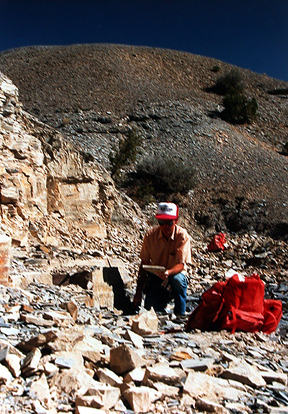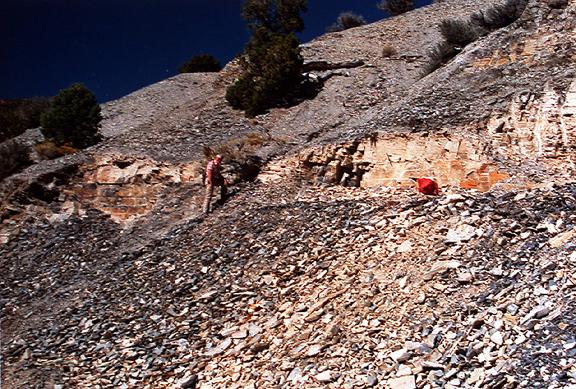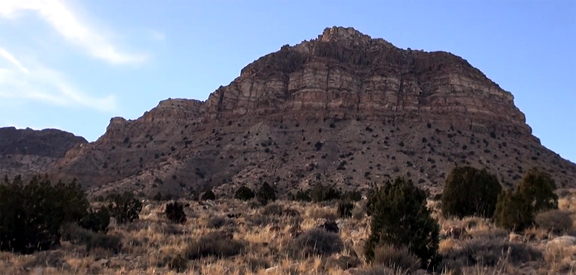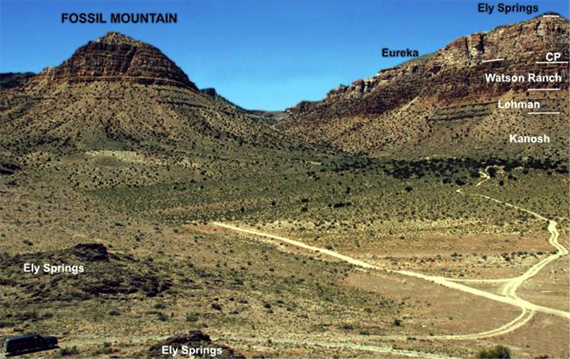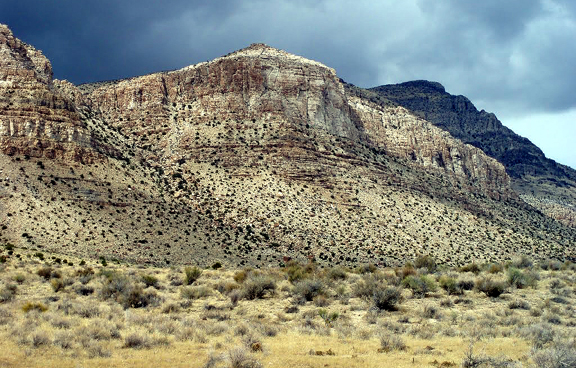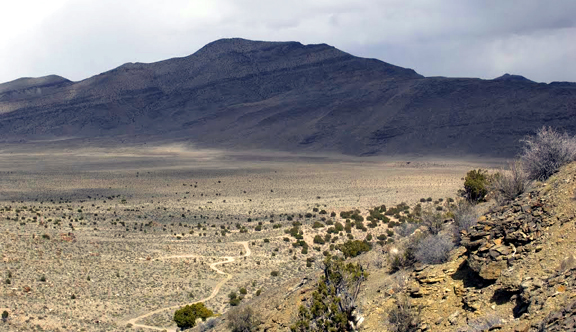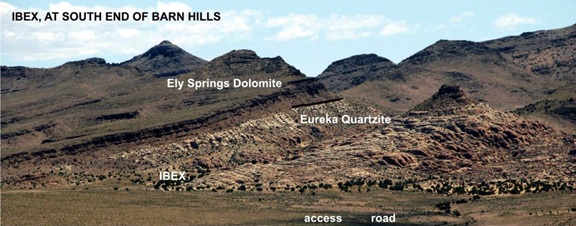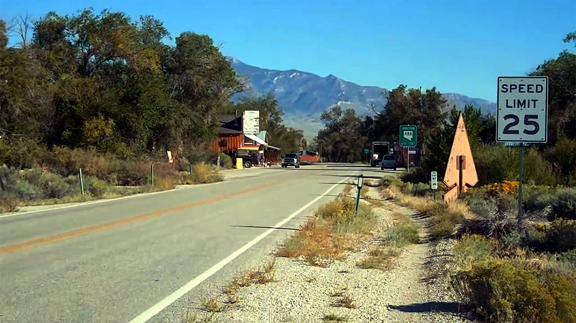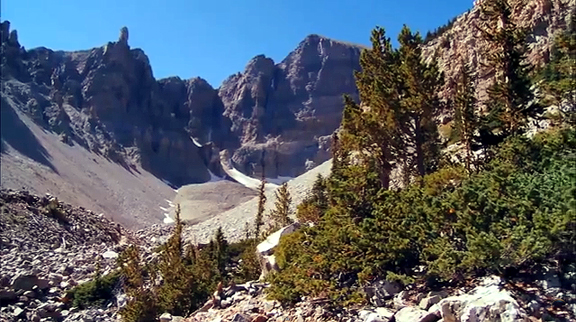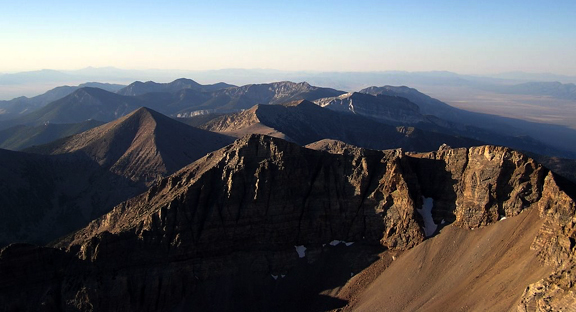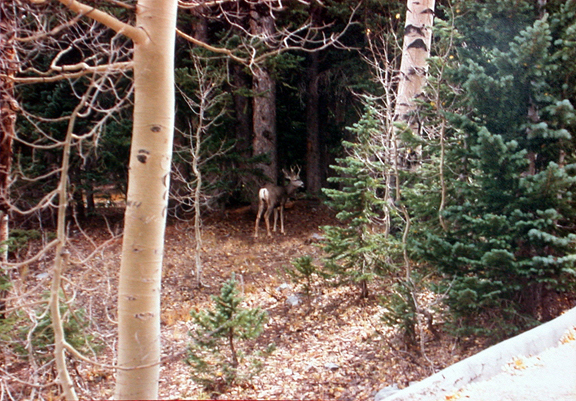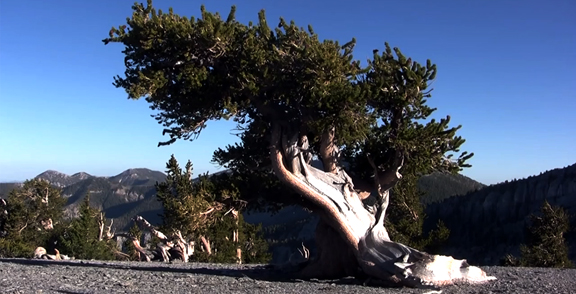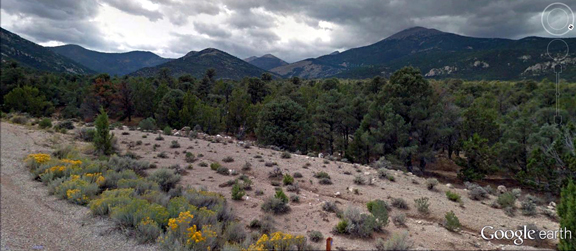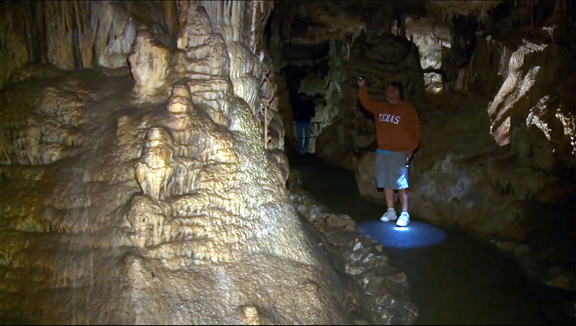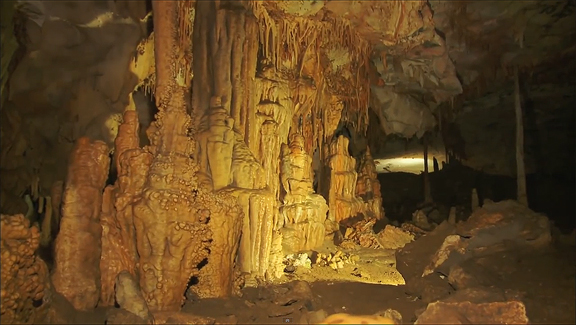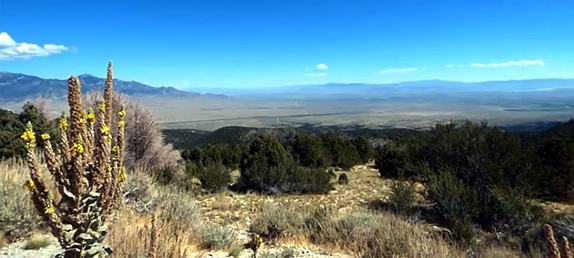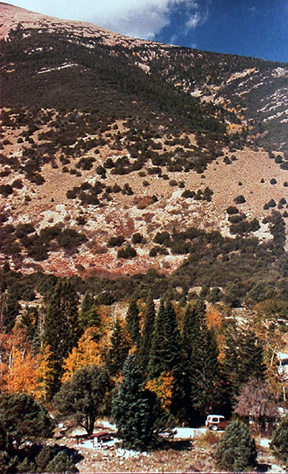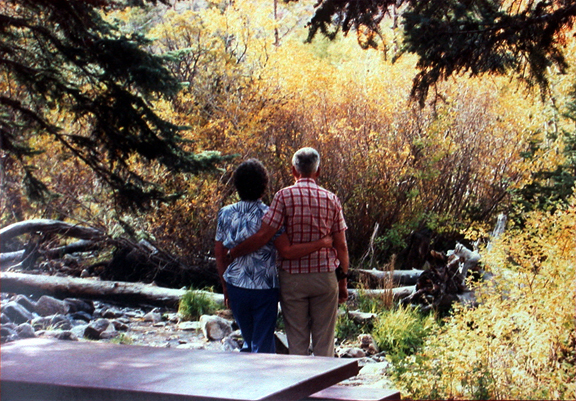|
Part 1--Wheeler Amphitheater
Millard County in western Utah is world-famous for its
early Paleozoic fossil localities--a vast, sparsely inhabited
area that holds numerous prolific paleontologic places of middle
Cambrian through early Ordovician geologic age some 510 to 470
million years old. Indeed, this eastern Great Basin Desert region
could well hold the best preserved and most complete succession
of 510 to 485 million year-old middle to late Cambrian trilobites
in the world. The renowned Wheeler Amphitheater locality in particular--also
called Antelope Spring--in the House Range attracts eager paleontology
enthusiasts year-round to an extraordinarily productive commercial
fossil quarrying operation, where for a reasonable fee visitors
may collect common, complete trilobites from the middle Cambrian
Wheeler Shale, around 505 million years old; these include prodigious
numbers of stunning specimens of a genus-species scientists call
Elrathia kingii, probably the single most readily recognizable
trilobite variety on earth. It is indeed a world-class fossil
district.
While Cambrian trilobites continue to draw fossil seekers
to these breathtakingly beautiful Great Basin environs, there
are numerous additional sensational paleontologic localities
scattered across Millard County.
Probably the best of the lot is Fossil Mountain in the
informally designated Ibex District. Here can be found a veritable
treasure trove of wonderfully preserved invertebrate fossils
dating from the early Ordovician age of approximately 485 to
470 million years ago. Among the fossil groups documented from
Ibex are algae, brachiopods, bryozoans, corals, cephalopods,
conodonts, echinoderms, gastropods, graptolites, ostracods, pelecypods,
sponges, and trilobites. Preservation of the brachiopods in particular
rivals that of the Midwest region of the United States--specimens
universally regarded as the most exquisitely preserved late Paleozoic
(Mississippian, Pennsylvanian, and Permian Periods) organisms
in the world. Around 3,500 feet of lower Ordovician sedimentary
rocks are exposed at Ibex, and the material is for the most part
unmetamorphosed by the geologic forces of heat, pressure, and
hydrothermal alteration--pervasive processes that have invariably
obliterated much ancient animal life in Paleozoic Era strata
exposed throughout the western United States.
An excellent place to begin a Millard County paleontology
adventure is of course Wheeler Amphitheater in the House Range,
or as many fossil aficionados prefer to call the rich region:
Antelope Spring. That's where the fabulous middle Cambrian Wheeler
Shale attains its ultimate geological and paleontological development,
where quite conveniently that successful commercial fossil dig
allows visitors to come on in and collect for a reasonable fee
any number of whole, perfect trilobite carapaces.
The history of fossil collecting at Wheeler Amphitheater
probably begins with the prehistoric Ute Indians, who archaeologists
aver used not a few of the extinct arthropod trilobites as amulets
to help repel injury during battle. But there is no doubt that
a Henry Engelmann, who accompanied geologist J. H. Simpson on
the very first earth science expedition to Millard County in
the mid 19th Century, made the initial historic recorded trilobite
find at Antelope Spring in 1859. Simpson eventually provided
paleontologist/geologist Fielding Bradford Meek with the Wheeler
Amphitheater trilobites Engelmann had collected during the Utah
explorations--specimens that Meek described for the first time
in a peer-reviewed scientific paper in 1876, shortly before his
death. In the early 1870s geologist G. K. Gilbert, aware of Engelmann's
fossil discoveries, visited Antelope Spring and measured upwards
of 2,300 feet of middle Cambrian strata, collecting in the process
numerous trilobites subsequently identified and described by
famous Cambrian paleontologicst C. D. Walcott, who during expeditions
to Wheeler Amphitheater in 1903 and 1905 not only recovered additional
abundant fossil material, but also measured the entire middle
to late Cambrian sequence exposed in the general vicinity--a
sedimentary succession now known to contain the following geologic
rock formations: middle Cambrian Howell Limestone; middle Cambrian
Dome Limestone; middle Cambrian Swasey Limestone; middle Cambrian
Wheeler Shale; middle Cambrian Marjum Formation; middle Cambrian
Weeks Limestone; upper Cambrian Orr Formation; and upper Cambrian
Notch Peak Formation (uppermost part is lower Ordovician). Walcott
officially named what's now universally recognized as the world-famous
middle Cambrian Wheeler Shale in a scientific paper in 1908.
After Walcott's contributions, the proverbial paleontological
flood gates open on scientific exploration of the House Range
and its incomparable middle to late Cambrian geologic section;
scientific research papers now abound.
At Wheeler Amphitheater, only a rather narrow 17-foot thick
section in the upper portions of the middle Cambrian Wheeler
Shale produces significant concentrations of fossil remains.
This is the precise interval that's presently mined commercially
for paleontologic specimens, having operated more or less continuously
since the late 1960s when an enterprising entrepreneur recognized
that, fortuitously, the richest trilobite horizon occurred in
an easily accessible valley or "amphitheater" on Utah
state-owned lands, which could legally be leased for natural
resource exploitation.
While collecting within that specific 17-foot thick zone
of optimal trilobitic presence, fossil seekers catch on pretty
quickly that despite the common occurrence of exceptionally well
preserved trilobite exoskeletons in the rocks--most often discarded
arthropod molts, shed each time the animal underwent a spurt
of growth (identical to modern arthropod insects, crabs, and
spiders who during growth cycles regularly drop their old body
armor for newer external coverings)--only three species pop up
with any kind of regularity. These include Elrathia kingii
(the most famous trilobite in the world), Asaphiscus wheeleri,
and Peronopsis interstricta. Much rarer trilobite finds
invariably constitute carapaces of Bolasidella housensis,
Altiocculus harrisi (formerly Alokistocare harrisi),
and Olenoides nevadensis. Excluding casual surface collecting
atop the numerous spoils piles, searching for prize specimens
others might have left behind or overlooked (a method that often
discloses excellent material, by the way), the most efficient
collecting method is to attempt to split sizable shale chunks
along their original planes of sedimentary deposition with a
geology rock hammer/pick. An optional technique involves utilizing
a selection of well-tempered chisels in combination with the
rock pick.
What you'll find in both instances is that with a gentle,
firm rapping the trilobites tend to pop out of the rocks whole
and complete, often in an essentially perfect state of preservation.
This unusual style of fossil occurrence developed when dolomite
(magnesium carbonate) precipitated in the trilobite carapaces,
forming in effect "trilobite nodules" that only await
a patient collector to crack them free. Practical experience
has demonstrated here that on average most collectors find anywhere
from 10 to 20 trilobites in a four-hour period; the majority
of trilobites unearthed range from under an inch to two inches
in length. Occasionally a few specimens could reasonably require
special prepping with perhaps an abrasive air scribe, to remove
sedimentary particles that obscure key features of the trilobites,
although in actual fact most finds need little more than a careful
washing with water and a toothbrush. Sometimes, though, it's
aesthetically appropriate to retain trilobites in their natural
state of preservation--still residing along the bedding planes
of the middle Cambrian Wheeler Shale, where they dropped to a
tropical sea floor accumulating silty detrital particles some
505 million years ago.
At that distant middle Cambrian date, today's Wheeler Amphitheater
existed as unlithified marine muddy ooze at rather shallow depths
several miles off the northwestern coastline of an ancient continent
geologists call Laurentia--the paleo-precursor to what eventually
became North America--then situated slightly south of the equator
in what's today the southern Bay of Bengal, between India and
Thailand. Over the course of geologic time, continental drift
has carried the once-tropical trilobite beds northeastward thousands
of miles into the temperate latitudes of present-day North America,
where they now outcrop within the eastern reaches of the Great
Basin Desert.
Within the House Range geographic province, paleontologists
have identified some 35 species of trilobites from the middle
Cambrian Wheeler Shale, although such extinct arthropods aren't
the only fossil varieties waiting to be found. Also present in
less frequent numbers are brachiopods; echinoderms, including
an eocrinoid ("dawn crinoid") called Gogia;
Phyllocarids (a bivalve crustacean with only two known living
members)--including the extinct Brachiocaris and Pseudoarctolepsis;
such early siliceous sponges as Diagonella, Choia,
and Chancelloria; an early Chelicerate (horseshoe crabs,
sea spiders, and arachnids are living members) called Esmeraldella;
Naraoia, a so-called trilobitomorpha, or "soft-bodied
trilobite"; Anomalocaris, the largest predator of
the Cambrian seas; annelids (the worms), including famous Wiwaxia,
which was first described from the astounding middle Cambrian
Burgess Shale of Canada; and 20 species of non-mineralized arthropods
unrelated to trilobites--in other words, soft-bodied animal remains
rarely encountered in the fossil record.
In general, the soft-bodied fauna occurs in sedimentary
layers where skeletonized animals remain absent; why this is
so puzzled investigating paleontologists, until a recent taphonomic
analysis of the Wheeler Shale fossil beds disclosed that Elrathia
trilobite-dominated biofacies accumulated under dysaerobic conditions
(low oxygen levels) that allowed frequent bioturbation (organisms
burrowing through the unconsolidated muds)--fasciliating rapid
decomposition of soft tissues in the presence of greater oxygen
content--whereas the non-mineralized (soft-bodied) creatures
were preserved when decay-inducing bacterial activity and bioturbation
became restricted by anoxic sediments lacking oxygen.
I first visited Wheeler Amphitheater several years ago
during a three-week summer vacation with my parents to eastern
Nevada and western Utah. From our base camp at Baker Creek Campground
in Great Basin National Park, Nevada (campsite #16, by the way--elevation
roughly 7,500; Great Basin NP is a terrific place to visit when
exploring the world-class paleontology of Millard County) we
headed out to classic Wheeler Amphitheater in dad's old ruggedly
reliable 1979 American Motors Corporation (AMC) CJ7 jeep he'd
purchased in Olathe, Kansas. I recollect that we gassed up in
Baker, Nevada, grabbed a few snack items and associated carbonated
beverages (AKA, sodas), then moved out into the brilliant early
eastern sun along a lonesome stretch of asphalt. Probably we
spotted no more than three or four vehicles during the entire
journey through timeless expanses of eastern Great Basin Desert.
As navigator and lead research archivist for the Millard trek,
I kept all pertinent road maps and scientific documents close
at hand, prepared for quick inspection should contingency referencing
become necessary.
What I remember distinctly is that we found the correct
turnoff to Wheeler Amphitheater without difficulty. Easily spotted,
indeed. After maneuvering along a system of surprisingly well-graded
dirt roads through stupendous isolation, we reached our desert
destination bursting with keen anticipation of a joyful paleontological
adventure. We were not disappointed. For the next four hours
or so we moved about the commercial quarry with a fevered zeal,
splitting 505 million year-old middle Cambrian Wheeler Shale
to find within several excellently preserved Elrathia kingii
trilobites that popped out of their muddy matrixes whole and
intact with but a gentle rock hammer tapping. This was discovery
ecstasy.
505 million years earlier we would have been floating atop
a warm, shallow sea off the northwest coast of North America's
ancestral continental mass situated slightly south of the equator
at the southern end of today's Bay of Bengal, between India and
Thailand. With living trilobites below us, the sun shines roughly
four percent dimmer than at Wheeler Amphitheater in a sky whose
atmospheric carbon dioxide levels exceed an approximated 4,000
parts per million--at least ten times higher than CO2 readings
of earth's last 100 Recent years--and average temperatures approach
77 degrees Fahrenheit, 27 degrees higher than a little over a
half billion years hence. A look shoreward from the Cambrian
sea discloses a landscape devoid of vegetation and animal life--an
early Paleozoic scene reminiscent of portions of the Great Basin
Desert, as observed from a distance in a moving vehicle through
Millard County to Wheeler Amphitheater some 505 million years
later.
Part 2--Fossil Mountain
After visiting classic Wheeler Amphitheater to sample an
amazing concentration of trilobites in the middle Cambrian Wheeler
Shale, it's time for a rendezvous with Fossil Mountain in the
Ibex District--a regional Millard County locale named for a European
wild goat in the 1890s by English immigrant Jack Watson, who
established a post office on property he homesteaded a few miles
north of what later became known as Fossil Mountain, proper.
The abundant fossil organisms at Ibex and Fossil Mountain
occur in the roughly 485 to 470 million year-old lower Ordovician
Pogonip Group, an association of six distinct and easily identifiable
geologic rock formations. This major stratigraphic succession
can be traced throughout western Utah and extreme eastern Nevada
(the Pogonip Group of eastern California is composed of several
different formations), but nowhere is it as fossiliferous as
in the Ibex area, where silty carbonate beds several feet thick
often consist of nothing but exceptionally well preserved brachiopods,
gastropods, ostracods, trilobites, or echinoderms--each animal
type characteristically contributing its specific remains solely
to an individual shell bed, to the exclusion of all other invertebrate
varieties. Such technically termed monotypic shell beds are extensively
developed in the Pogonip at Ibex's Fossil Mountain, and the fossil-saturated
ledges can be followed for considerable distances.
I had long heard reports of the remarkable paleontologically
prolific formations of the Ibex District--had even viewed stunning
brachiopod specimens from the lower Ordovician Kanosh Shale exposed
there. Nevertheless, I was dutifully skeptical of the reportedly
extensive, bountiful fossil occurrences. Many times in the past
I'd been given "reliable" information about a rave-review
region, only to find out that it could not live up to its advance
billing. A fossil dealer at a mineral show once touted Ibex,
talking on and on about the unbelievable abundance of fossils
available there, but at the time I was busy researching another
specific locality and his credible recommendations went over
my head.
At a rock shop in Calico Ghost Town, in California's Mojave
Desert a few miles east of Barstow, the proprietor made a special
point of showing off his Millard County specimens, including
chunks of brachiopod material from Ibex that were beyond belief.
By now my interest in the region was solidifying, but there just
didn't seem to be any spare time to get away and properly explore
the place.
When at last I finally made the trip to Ibex, I was not
disappointed. As the well-worn saying goes, you have to see it
believe it. The rocks are relatively flat-lying, in a horizontal
bedding orientation, and erosion has created natural ledges along
these bedding planes. Fossil hunters can simply hike along the
strike of the strata--in other words, along the horizontal direction
of the rock layers--and pick of free-weathered fossils at will,
in addition to innumerable quality chunks of fossil-bearing limestones
and shales.
From personal experience, I can recall few Paleozoic Era
localities that have yielded such a profusion of excellent forms.
Midwestern exposures certainly come to mind. While I was residing
in eastern Kansas a number of years ago, I had the great fortune
to explore several of the abandoned rock quarries in the area.
These have penetrated late Pennsylvanian limestones and shales
approximately 305 million years old, in which a mind-boggling
diversity of beautiful specimens occur. One quarry just a few
miles outside of town came to be my very favorite--the single
finest Pennsylvanian Period fossil-bearing site from which I
have ever collected.
If that quarry happens to rank as the best Pennsylvanian
fossil locality, then there is no doubt that Fossil Mountain
at Ibex is the finest Ordovician Period fossil-yielding area
I have visited. It is true, of course, that I have yet to explore
the famous Ohio Ordovician outcrops.
Although Fossil Mountain of Ibex lies within a proverbial
no man's land--parched desert many miles from the nearest center
of population (that would be Delta, Utah)--the fossil-bearing
area is rather easily reached via a system of well-maintained
dirt roads. Still, this no place to become stranded. Make certain
that your vehicle is in perfect working order. Carry a well-maintained
emergency first aid kit, extra food, and plenty of water: The
traditional rule stresses that one must possess at least one
gallon of water per person per day in reserve for the duration
of an expected dry-camping expedition. And notify local authorities
in Delta--or, Baker, Nevada, if one is traveling to Millard County
from directions west--of your destination and how long you plan
to stay. But be sure to contact them when returning to civilization,
so they won't organize a rescue operation unnecessarily. While
in the neighborhood of Baker in White Pine County, eastern Nevada,
by the way, consider a visit to Great Basin National Park--established
October 27, 1986; beaucoup scenic wilderness adventures await,
and Baker Creek Campground at an elevation of roughly 7,500 feet
makes a most comfortable base camp during summer visits.
Those of us who travel the desert regularly sometimes develop
a lazy attitude toward these important reminders. I freely admit
that I have on occasion broken the rules of safe and sane backroads
travel conduct. Just call me lucky so far. So, don't do as I
do--as the saying goes--do as I say.
Note, too, that Ibex's Fossil Mountain presently lies within
the proposed King Top Wilderness area. This means that only surface
collecting of fossil specimens is allowed--do not dig into the
exposed strata; pick up and keep only what you find already lying
atop the ground. And before proceeding into the wilds, check
with the local Bureau of Land Management office (BLM) to determine
the latest land status. If the region eventually goes the route
of a federally protected wilderness, unauthorized amateur collectors
will likely incur additional restrictions on their hobby fossil-finding
activities. Obey all rules and regulations. For example, fossils
collected on America's Public Lands (administered by the BLM)
must never be sold or bartered--in legal argot, generally agreed
by common convention to mean that you can't trade for specimens,
either. Watch for BLM signs along the way that detail the latest
official public lands status.
After negotiating a system of decently maintained dirt
roads through several lonesome miles of classic Great Basin Desert
terrain, one arrives at excellent exposures of the lower Ordovician
Lehman Limestone--the first prominent and easily accessible outcrops
of the paleontologically prolific Pogonip Group one encounters
within view of looming Fossil Mountain, now less than two and
a half miles away. The rugged slopes to the right of the dirt
trail (north) consist of blue-gray-weathering arenaceous limestones
in which moderately common brachiopods, ostracods (a small bean
to pea-shaped bivalve crustacean), and gastropods occur. Yet
another paleontological point is that the first corals in the
local Ordovician Ibexian stratigraphic record happen to appear
in the Lehman Limestone.
This is an advantageous place to become acquainted with
the regional style of rock outcropping and fossil occurrences
in the Fossil Mountain/Ibex District. You will note that the
limestone layers here are essentially flat-lying, in what geologists
call a horizontal bedding attitude. Considering the extreme geologic
age of the Lehman Formation--some 470 million years old--the
lack of metamorphism and related deformation of the Ordovician
strata is absolutely astonishing.
The Lehman limestones tend to form prominent ledges, while
the shale partings have been eroded back in recess. This is the
distinctive geomorphological characteristic of all the exposed
early Paleozoic rock formations in the Ibex District. Not every
carbonate layer here is fossiliferous but, rather, the specimens
occur in specific zones or horizons throughout the sequence.
Some beds yield only ostracods, while others are packed with
brachiopods, echinoderms, trilobites, or gastropods.
The Lehman Limestone is the youngest of the six geologic
rock formations included in the geographically widespread lower
Ordovician Pogonip Group--roughly 485 to 470 million years old--which
reaches its most abundant and reliably diverse fossil development
at Fossil Mountain and the surrounding Ibex area. In descending
order of geologic age, this significant grouping of strata includes,
first, the Lehman Limestone, then the Kanosh Shale, the Juab
Limestone, the Wah Wah Limestone, the Fillmore Formation, and
the House Limestone. In general, all Pogonip rocks but the House
Limestone yield plentiful fossils. This is not to say that the
House is a disappointing unit; it's just that its ledges of silicified
trilobites are more difficult to spot in the field.
After examining the Lehman Limestone outcrops, one continues
along the primary dirt road to another branching dirt trail.
Which way to go to get to Fossil Mountain is now no longer even
a question. At this point Fossil Mountain--the primary fossil-bearing
locality in the Ibex District--looms to your immediate northwest,
a great pyramid-shaped protuberance composed of a conformable
(i.e., without any breaks in time in the geologic history of
sedimentary deposition) sequence of lower Ordovician through
middle Ordovician-age strata capped by the erosion-resistant
middle Ordovician Eureka Quartzite (not a member of the Pogonip
Group)--a massive accumulation of heat and pressure-altered sandstones
that are in large part responsible for the protection of the
fossiliferous limestones and shales below. They have prevented
the erosion of the less-resistant Ordovician rocks in much the
same manner that a small pebble resting atop a glob of mud will
keep the mud mound intact through a rainstorm, while soil exposed
to the brunt of the storm easily washes away.
Immediately below the brilliant white Eureka Quartzite
capstone on Fossil Mountain are two additional rock formations
geologists exclude from the early Ordovician Pogonip Group: The
darker band below the quartzite peak is the middle Ordovician
Crystal Peak Dolomite; and that bold, steep cliff face composed
of alternating white and brown bands is the middle Ordovician
Watson Ranch Quartzite, underlain in turn by a narrow, prominently
protruding limestone ledge belonging to the lower Ordovician
Lehman Limestone, the youngest member of the Pogonip Group. According
to several official geological measurements, early to middle
Ordovician-age rocks in Millard County accumulated to an aggregate
thickness of some 3,500 feet.
At the intersection with the north-south trending dirt
road that leads over to Fossil Mountain, you will note to the
right of the road a magnificent exposure of the middle Ordovician
Eureka Quartzite--the same geologic interval that caps Fossil
Mountain. This is certainly one of the most widespread early
Paleozoic Era rock units in all the Great Basin Desert. It has
been recognized as far away as eastern California, in the mountains
surrounding Death Valley National Park.
For decades, scientists have speculated on the original
environment of deposition of the Eureka Quartzite, an unusually
thick bed of heat and pressure-crushed sandstone. Many models
have been analyzed, but no one explanation seems to answer all
the questions.
The main problem for geologists is to satisfactorily account
for such a massive, persistently uniform zone of practically
pure metamorphosed sandstone that occurs over hundreds of square
miles. It hasn't been easy. After much debate on the subject,
earth scientists remain puzzled and intrigued, although recent
investigations seem to show that the Eureka Quartzite accumulated
some 465 million years ago as clean, well-sorted beach sand along
the shores of a shallow sea during the middle portion of the
Ordovician Period.
If this is true, the Eureka Quartzite could well represent
one of the oldest identifiable terrestrial rock deposits in North
American.
A short drive beyond the Eureka Quartzite exposure brings
you directly in front of the place you want to visit.
Before you rises Fossil Mountain, one the great early Ordovician
fossil-bearing sites in existence. It was named--and first popularly
publicized--sometime between 1910 and 1920 by Frank Ashel Beckwith,
a cashier at the first established bank in Delta, Utah, who spent
considerable spare time exploring the fossil wonders of Millard
County. Among a shipment of early Ordovician invertebrate fossils
that Beckwith donated to the US National Museum (part of the
Smithsonian Institution in Washington D.C.), a selection of brachiopods
became the first paleontologic specimens from Fossil Mountain
ever formally described in the scientific literature (1936 and
1938); mysteriously, though, the paleontologists who wrote up
the papers failed to credit Beckwith as the donor.
A short walk toward Fossil Mountain will place you on the
ledge-forming, dark-blue silty limestones of the Wah Wah Limestone.
Silicified trilobites, algae-sponge patch reefs, conodonts (a
minute feeding apparatus, unrelated to modern jaws, from an extinct
eel-like organism--seen only in the insoluble residues of carbonates
dissolved in a dilute solution of acetic or formic acid), graptolites,
gastropods, brachiopods, solitary sponges, nautiloid cephalopods,
and cystoid echinoderms constitute members of a large and diverse
fossil assemblage.
The Wah Wah Limestone in the vicinity of Fossil Mountain
is about 235 feet thick. It is traceable southward from the parking
area for a little over a mile, and fossils can be collected throughout
this entire area of outcrop.
As in the Lehman Limestone explored earlier, the Wah Wah
specimens (yes, the Wah Wah is colloquially called "The
George Harrison interval, where all things Ordovician must pass"...)
tend to occur in distinct zones. This means that productive,
fossiliferous horizons are separated by many feet of barren limestone
and shales. The trick, naturally, is to locate these fossil-rich
ledges, then follow them as they arc about the hillsides.
As you ascend the slopes of Fossil Mountain, the Wah Wah
Limestone grades into the younger Juab Limestone, which consists
mainly of medium-gray arenaceous limestone that forms ledges
up to four feet thick. There are also minor interbeds of tan
shale in the sequence.
Despite the fact that the Juab is a relatively thin geologic
unit--only 160 feet at most--many fossil types are well-represented.
Brachiopods, gastropods, cephalopods, trilobites, conodonts,
solitary sponges, and graptolites are especially characteristic
of the formation.
Directly above the Juab Limestone lies the next-youngest
formation, which also happens to be the most fossiliferous lower
Ordovician Pogonip Group unit of them all--the fabulous Kanosh
Shale. Simply continue your hike upward along any of Fossil Mountain's
numerous erosion gullies and you will soon intersect the unmistakable
olive-brown to chocolate-brown shales that tend to form slopes
and protruding ledges.
Here you will discover a profusion of fossils--especially
orthid-type brachiopods which form beautiful museum-quality shell
beds (also called monotypic beds); these are accumulations of
prodigious quantities of a single species of brachiopod, only,
that typically form a great percentage of the rocks in which
they occur. Free-weathered brachiopods are abundant, as well--a
superior selection of plentiful pedicle and brachial valves,
plus fully articulated specimens with both valves preserved intact.
Researchers suggest that such Kanosh Shale monotypic shell
beds developed under supremely stressful paleo-environmental
conditions, probably when early Ordovician marine saline levels
rose to critical concentrations, initiating "brachiopod
blooms;" the brachs reacted to the increasingly intolerable
alteration of a once-salubrious sea geochemistry with adaptive
creativity; they opted to over-reproduce in sudden spurts, saturating
the Ordovician sea floor with great numbers of their kind, ensuring
that at least a few would persist and endure. On occasion, though,
the periodic prolific brachiopod blooms were ultimately overcome
by rapidly deteriorating conditions that proved fatal, and so
entire beds composed mostly of their multitudinous valves built
up on the sea floor.
Other fossil groups well represented in the Kanosh Shale
include ostracods--which often form their own impressive monotypic
shell beds--gastropods, bryozoans, cephalopods, pelecypods, graptolites,
echinoderms, sponges, conodonts, and trilobites. Many Kanosh
Shale bryozoans and echinoderms originally inhabited what paleontologists
call hardgrounds: that is, sections of the Fossil Mountain sea
floor created when early Ordovician storm waves exhumed abundant
inorganically precipitated calcareous nodules, forming discrete,
extensive beds of so-called "marine pavement." Upon
these newly developed areas early echinoderms (often, a rhipidocystid
eocrinoid) found a favorable environment to proliferate, contributing
when they died vast numbers of disassociated ossicles (also called
"stems" or columnals) and holdfasts--the minute, bulbous
attachments that allowed the animals to anchor themselves--to
the ever-thickening cemented substrate. Repeated echinoderm death
cycles created ever-expanding space for an even more diverse
echinoderm fauna to thrive, atop which, eventually, several species
of bryozoans came along to help colonize the hardgrounds areas,
as well--the first known bryozoans in the fossil record to inhabit
hardgrounds, which are also known from the preceding Cambrian
Period that ended some 10 million years before the Kanosh Shale
began to accumulate, a time prior to 485 million years ago when
only echinoderms contributed to hardground developments on the
early Paleozoic sea floors. So scientificially fascinating are
the Fossil Mountain examples that paleontologists and geologists
from all around the world travel to Millard County, Utah, to
study the classic Kanosh Shale hardgrounds.
This is a formation absolutely packed with wonderfully
preserved fossil material. Like others before me, I could rave
on and on about the excellence displayed here, the diversity
of early Ordovician animal groups and the quality of their preservation,
but you too will just have to see it to believe it. The Kanosh
Shale, with its fantastic brachiopod and ostracod shell beds,
early echinoderm-bryozoan hardground developments, and prolificly
diverse free-weathered invertebrate animal fauna, ranks as one
of the most important paleontologic exposures in North America.
To collect here is an exhilarating, uplifting experience--one
I will never forget.
The older Fillmore Formation and House Limestone are not
exposed on the immediate slopes of Fossil Mountain, but typical
fossiliferous outcrops can be found not far from the parking
area. There, the Fillmore is roughly 1,600 feet thick, consisting
of interbedded conglomerate, olive-gray to greenish shale, fine-grained
limestone, and occasional lenticular algae-sponge patch reefs;
other fossils present include graptolites, trilobites, brachiopods,
conodonts, gastropods, echinoderms, and cephalopods. Oldest of
the Pogonip Group formational subunits, the lowermost Ordovician
House Limestone yields silicified trilobites and brachiopods
through approximately the upper third of 500 feet of finely crystalline
limestone in beds two to four feet thick.
My first visit to the Ibex District provided me with an
extraordinary collection of early Ordovician invertebrate animal
specimens. I only wish I could have stayed longer.
While exploring the gullies and dry washes at Fossil Mountain,
I felt incredibly privileged to be collecting from such a remarkable
series of fossil-bearing geologic formations. They were deposited
some 485 to 470 million years ago in a warm shallow sea then
situated astride the equator--a deep time tropical ocean that
teemed with burgeoning early Paleozoic Era life. That varied
life of the early Ordovician has now been preserved in splendid
detail at Fossil Mountain, where neither the ravages of erosion
nor the brute force of metamorphism has harmed the ancient animals.
They now reside in the limestones and shales of a vanished age--kept
alive in their death for nearly half a billion years, longer
than the human mind can comprehend. The abundant and beautifully
preserved fossils at Ibex give us a rare glimpse back in time
to a unique association of animal life that will never exist
again.
|

